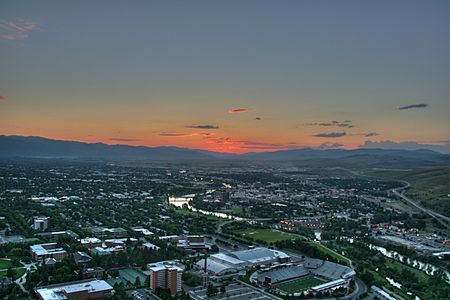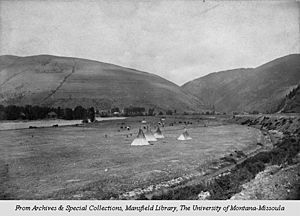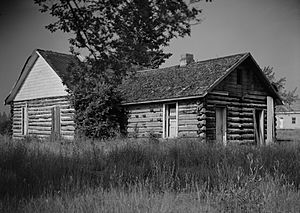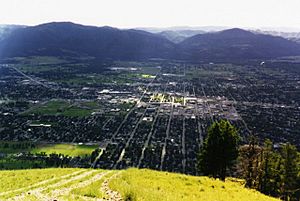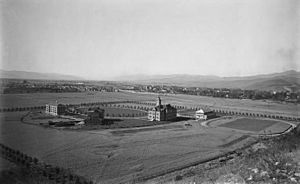History of Missoula, Montana facts for kids
The history of Missoula, Montana goes way back, even 12,000 years ago! That's when a giant ice-age lake finally drained away. The first European explorers, Lewis and Clark, visited the area in the early 1800s. The first permanent town was built in 1860.
Contents
Ancient Missoula: A Land Shaped by Ice
Imagine Missoula long, long ago! It was once at the bottom of a huge lake called Glacial Lake Missoula. This lake was enormous, covering about 3,000 square miles (7,800 km²). It stretched far north, south, and west of where Missoula is today.
This giant lake was held back by a huge ice dam. Over 2,000 years during the last Ice Age, the lake would fill up and then suddenly drain in massive floods, then fill up again. When the floods finally stopped, they left behind the Missoula Valley. This valley became a natural meeting point for five mountain valleys, surrounded by the Bitterroot, Sapphire, Garnet, Rattlesnake, and Reservation mountains.
The oldest things found here, like tools, are from about 12,000 years ago, right after the lake disappeared. The first known settlements date back to 3,500 BC. For hundreds of years, before Europeans arrived, many Native American tribes used this land. These included the Salish, Kootenai, Pend d'Oreille, Blackfeet, and Shoshone tribes.
Because the valley was a natural path through the mountains, it was a place of many battles between local tribes and those traveling to the buffalo-rich plains to the east. The narrow valley at Missoula's eastern entrance saw so much fighting that French fur trappers later called it "Porte d' Enfer," which means "Hell's Gate." This name stuck until 1866, when the area was renamed "Missoula."
Early Explorers and Roads
The first European Americans to visit the Missoula area were part of the famous Lewis and Clark Expedition. They stopped twice just south of Missoula at a place called Traveler's Rest. They were there in September 1805 and again in June-July 1806. On their way back from the Pacific Ocean, the expedition split up here. Clark went south along the Bitterroot River, and Lewis traveled north through Hellgate Canyon.
In the 1850s, Washington Territory governor Isaac Stevens explored the region. He was looking for a good route for a railroad across the country. Stevens also helped make the Treaty of Hellgate. Through this agreement, the Native American tribes of western Montana made agreements about their lands with the U.S. government.
Stevens was helped by Lieutenant John Mullan. Mullan built the Mullan Road in 1853. This wagon road was the first to cross the Rocky Mountains into the Pacific Northwest. It was very important because it helped establish Fort Missoula in 1877, a military post that played a role in the area's history.
From Hell Gate to Missoula Mills
The first settlement in the Missoula area began in 1860. It was a trading post founded by Christopher P. Higgins and Francis L. Worden. They set it up about five miles (8 km) west of today's Missoula, near what is now Frenchtown. They hoped that the Mullan Road and any future railroad would pass through the valley. They were right!
Hell Gate became the county seat for Missoula County in 1860. The first post office opened there in 1862. But Higgins and Worden wanted to build a lumber and flour mill. They needed a better water supply to power their mills. So, in 1864, the settlement moved upstream to its current location.
The new "Missoula Mills" quickly became the most important economic center in the valley. In 1866, it replaced Hell Gate Village as the county seat. The name "Missoula" comes from the Salish name for the Clark Fork River. Many people mistakenly think it means "River of Ambush" because of the past battles. However, the name nmesuletkʷ actually means "place of freezing/cold liquid," or simply "cold water." Some Salish tribal members believe this name refers to Glacial Lake Missoula itself.
Missoula Grows into a City
Missoula didn't have a sudden "boom" like some other western Montana towns during the gold rush. But it did grow quickly! By 1872, the town had 66 new buildings. Higgins and Worden opened the first stores and banks. Soon, they faced competition from other businesses, like the Missoula Mercantile Company.
Growth slowed down a bit in the 1880s. But then, the Northern Pacific Railway arrived in 1883, and Missoula started growing fast again! The Territorial Governor, Benjamin F. Potts, approved Missoula's charter to become a town. The railroad needed a lot of lumber for tracks and bridges. This led to many new sawmills opening, starting Missoula's important lumber industry.
This economic excitement led to the building of many historic buildings you can still see downtown today. A famous architect named A. J. Gibson arrived in the late 1880s. He designed many of Missoula's most recognizable buildings, including the Missoula County Courthouse and the University of Montana's Main Hall.
The University of Montana is Born
In 1893, Missoula made a deal with Helena, another city in Montana. Missoula agreed not to try to become the state capital. In return, Missoula won the vote to be the home of Montana's state university! This made the University of Montana (UM) the oldest college in Montana. Land south of the Clark Fork River was given for the campus. Downtown Missoula had grown up north of the river.
The 20th Century: Growth and Change
The railroad and lumber mills continued to bring money and people to Missoula. The city's population kept growing. In 1908, Missoula became a major office for the United States Forest Service. This agency even started training smokejumpers (firefighters who parachute into wildfires) here in 1942.
While there was a small dip in population from 1910 to 1920, Missoula has grown steadily since then. In 1909, a group called the Industrial Workers of the World held protests in Missoula. They were fighting for freedom of speech. Many of their members were held in the town's jails.
In the 1930s, during the Great Depression, Missoula received help from the government. Fourteen Civil Works Administration projects helped build the airport, the Orange Street Bridge, several schools, and four major buildings at the university.
Logging remained a key industry. In 1956, a large pulp mill opened. This led to protests because of the air pollution it caused. By the early 1990s, many logging operations had changed, and new laws helped clean the air. However, because Missoula is in a valley, smoke from forest fires and winter smog can still sometimes linger.
Missoula Today
The "modern era" for Missoula really began when the logging yards, which had once powered the city's economy, started to disappear. As logging changed, the Missoula Downtown Association was created. This group helped make downtown Missoula what it is today.
New buildings like the First Interstate Bank, the First Security Bank, the new St. Patrick Hospital and Health Sciences Center, and the Millennium Building (the second tallest building in Missoula) gave downtown a more modern feel. In 2010, the Garlington Building was completed, adding even more modern architecture to Missoula.
Missoula's Timeline: Key Moments
- 1805: The Lewis and Clark Expedition reaches Missoula.
- 1841: Father DeSmet brings the first wheeled vehicle through the valley.
- 1853-55: The Missoula area is surveyed by Isaac Stevens and John Mullan.
- 1855: The Hellgate treaty is negotiated.
- 1860: Christopher P. Higgins and Francis L. Worden set up the Hellgate trading post.
- Missoula County is created.
- 1860-61: The Mullan Road is built through the valley.
- 1864: A sawmill and gristmill are built east of Hellgate.
- Montana Territory is officially organized.
- 1865: Missoula Mills is founded.
- 1866: The county seat moves to Missoula Mills.
- 1869: Emma Stack Dickenson becomes Missoula's first teacher.
- The first bridge is built across the Clark Fork River.
- 1870: Missoula's first newspaper, "The Missoula and Ceder Creek Pioneer," is published.
- 1873: The first Higgins Avenue Bridge is built.
- St. Patrick Hospital opens.
- 1877: Fort Missoula is established.
- 1879: First telephones are installed.
- 1883: Missoula is approved as a town.
- The Northern Pacific Railway arrives.
- 1889: Electricity arrives in Missoula.
- Missoula officially becomes a city.
- Montana becomes a state.
- 1890: Horse-drawn streetcars begin service.
- 1894: Missoula Public Library opens.
- 1895: The University of Montana opens.
- 1908: The United States Forest Service Office is established.
- 1909: The IWW holds its first free speech fight.
- 1910: Electric streetcars are introduced.
- 1917: Jeannette Rankin becomes the first woman elected to the U.S. Congress.
- 1932: Streetcars are replaced by buses.
- 1940-41: Italian and Japanese Americans stay at Fort Missoula during World War II.
- 1947: Juliet Gregory is elected Missoula's first woman mayor.
- 1954: The Aerial Fire Depot is dedicated.
- 1965-66: Interstate 90 is built through Missoula.
- 1979: The last passenger train leaves Missoula.
- 1995: A Carousel for Missoula opens.
- 2000: Missoula passes Great Falls to become Montana's second largest city.
Images for kids


